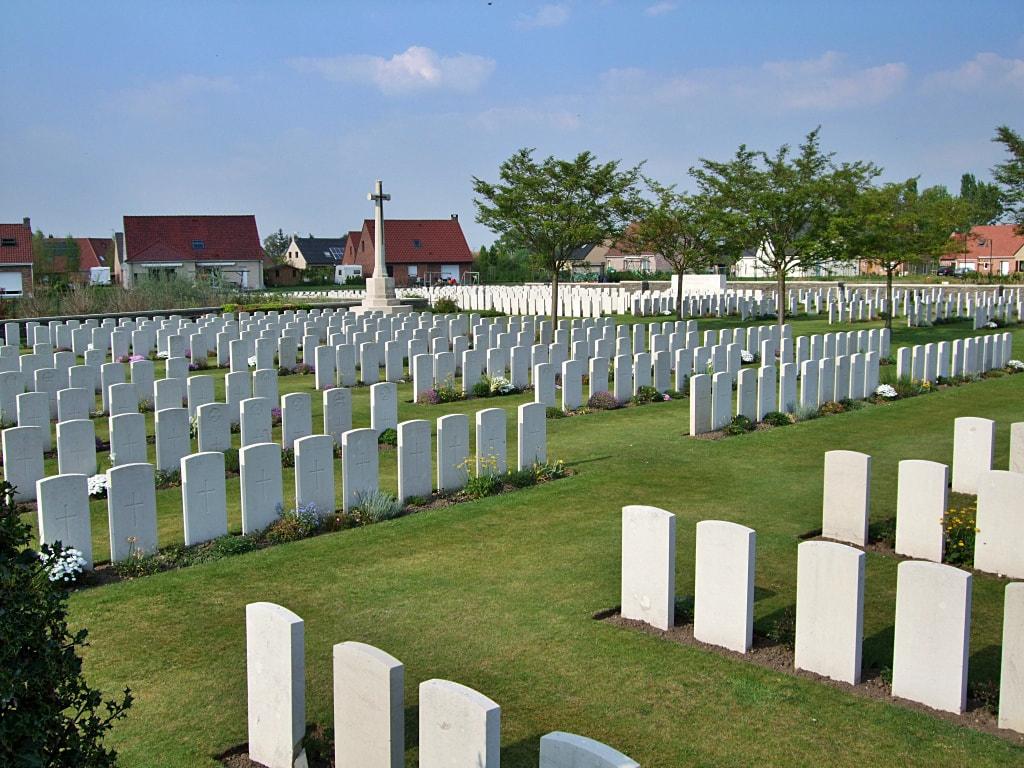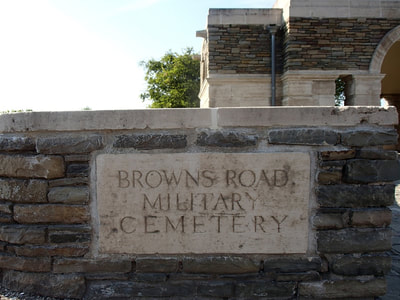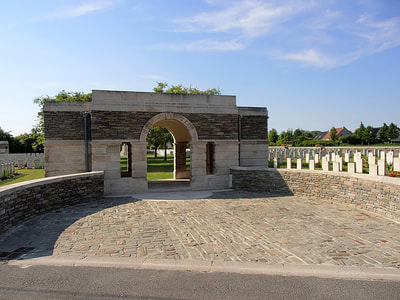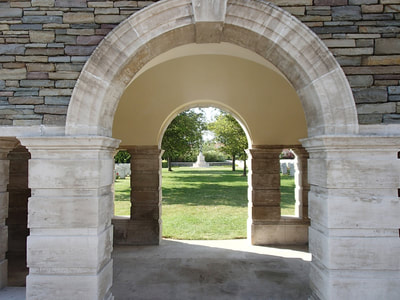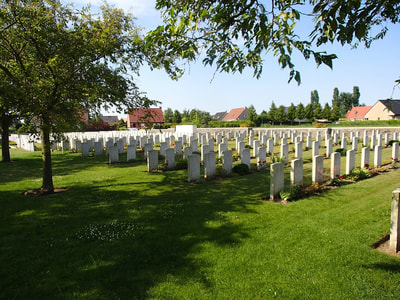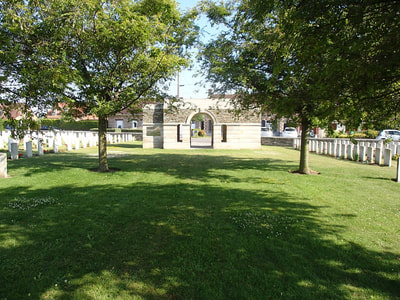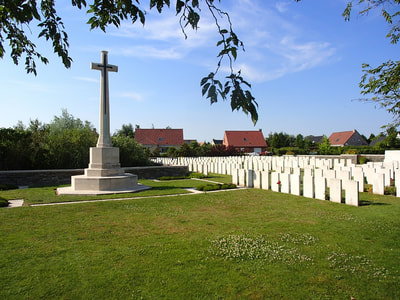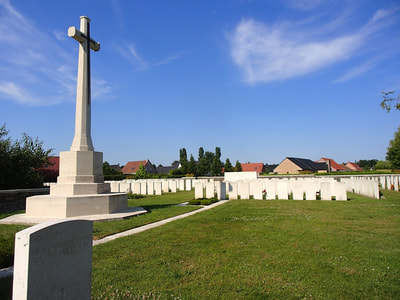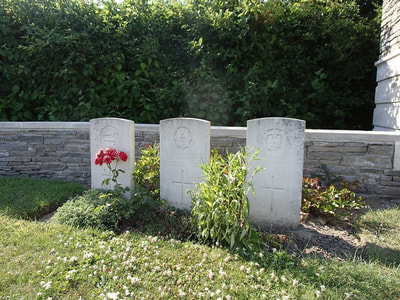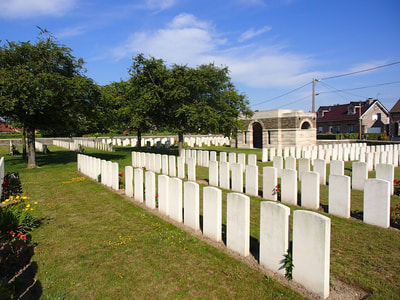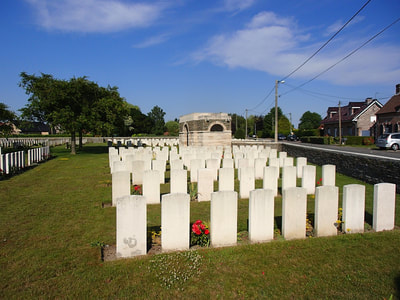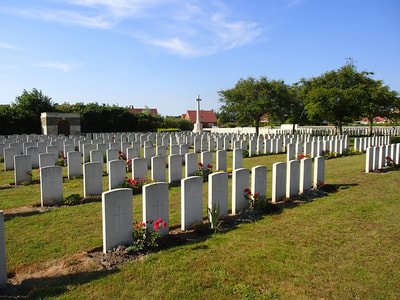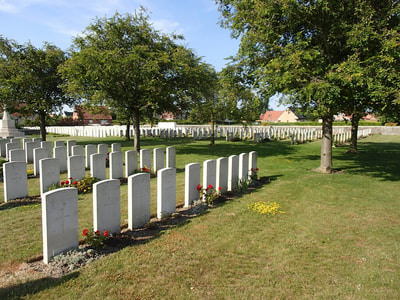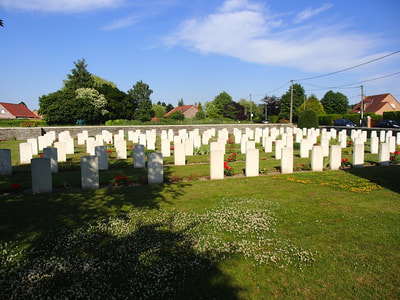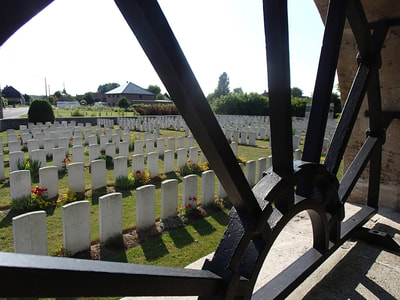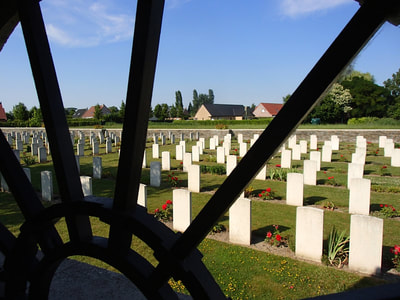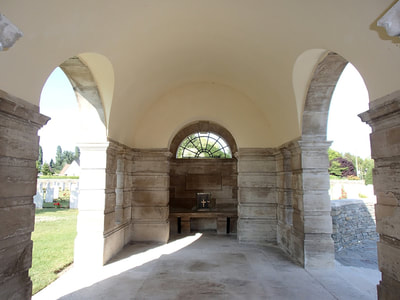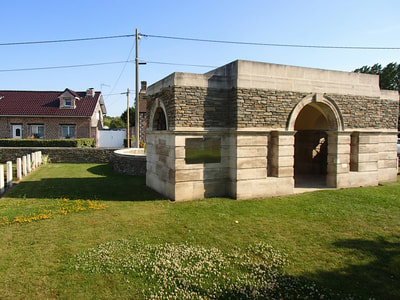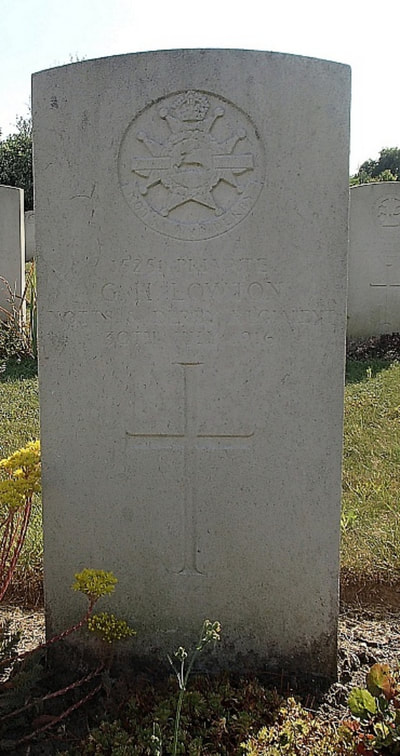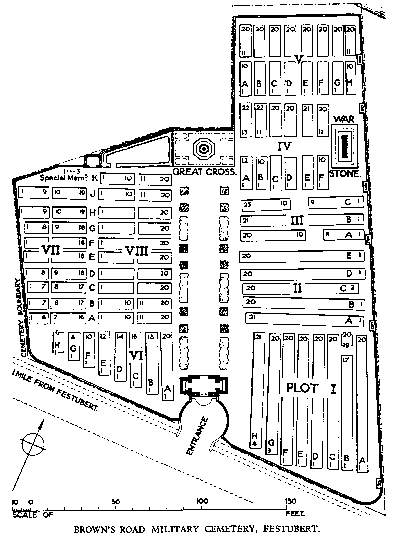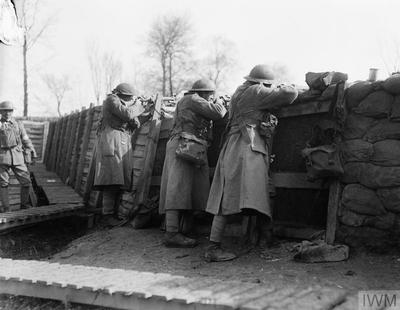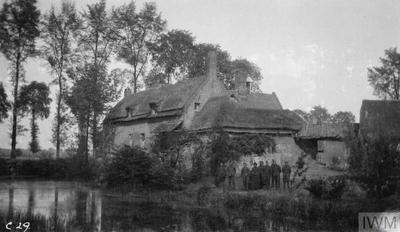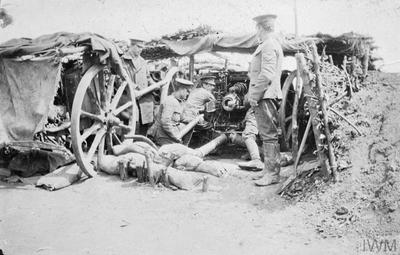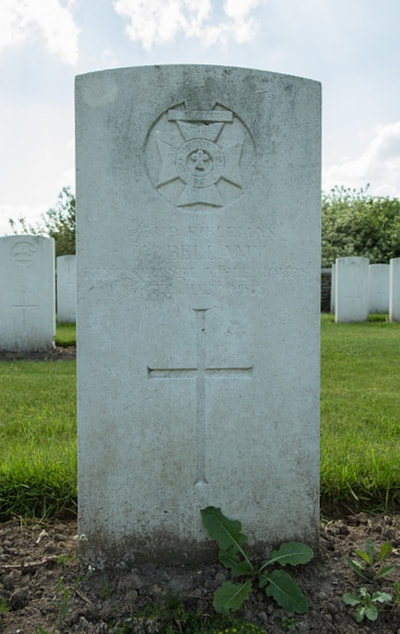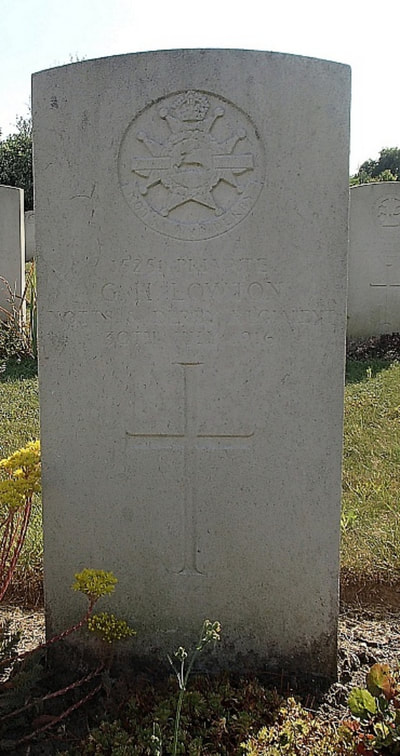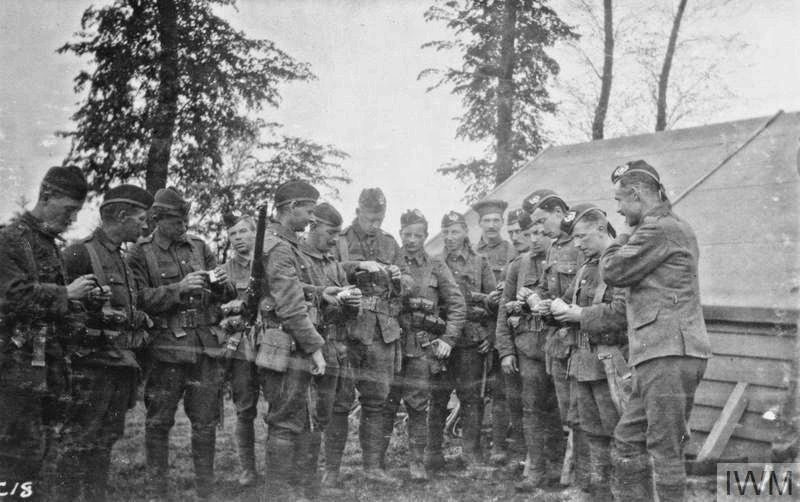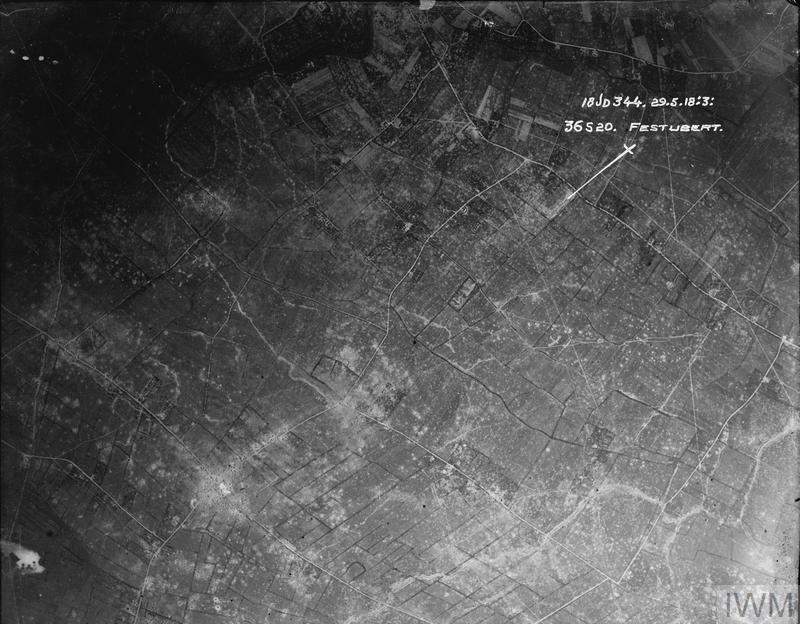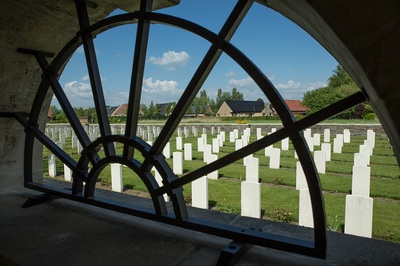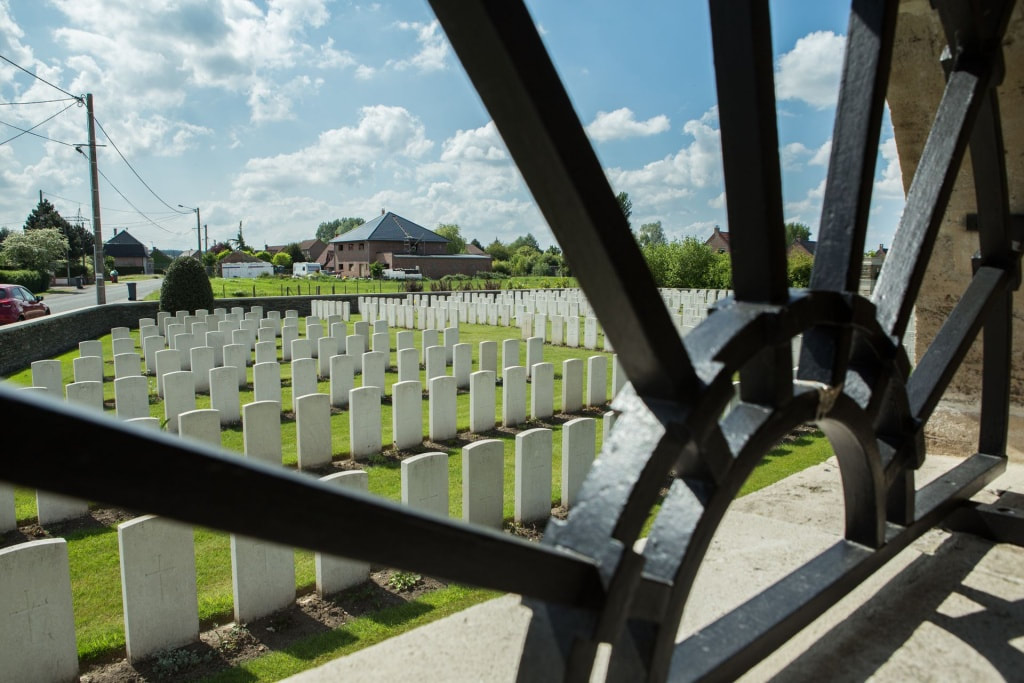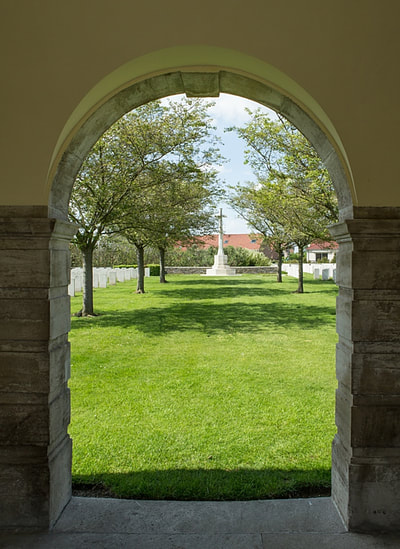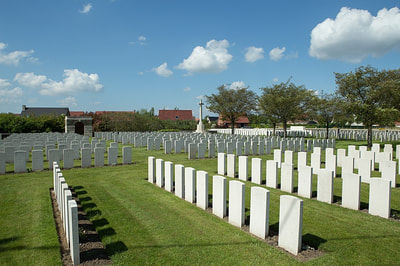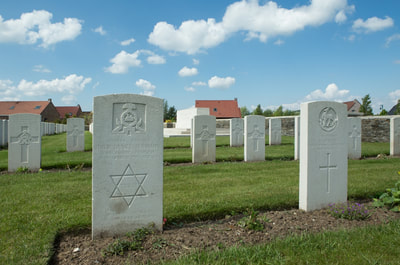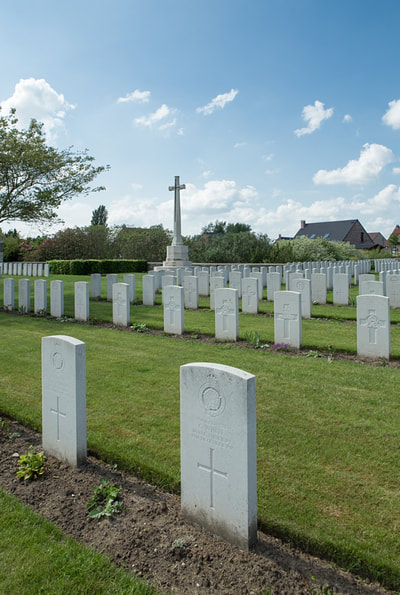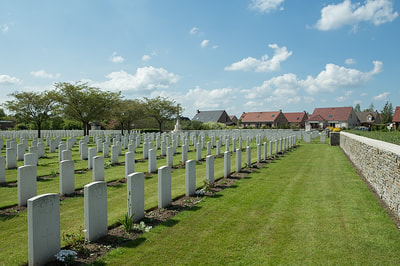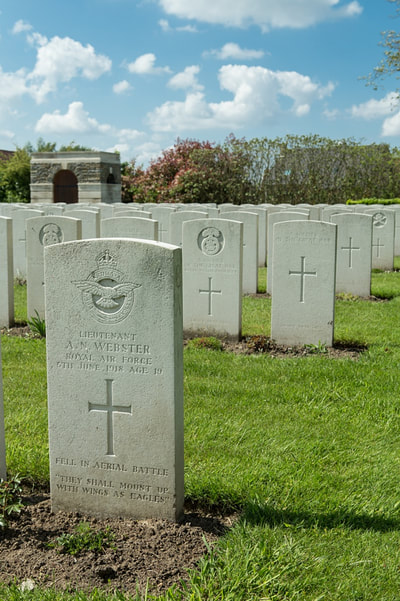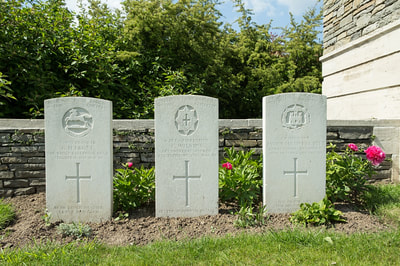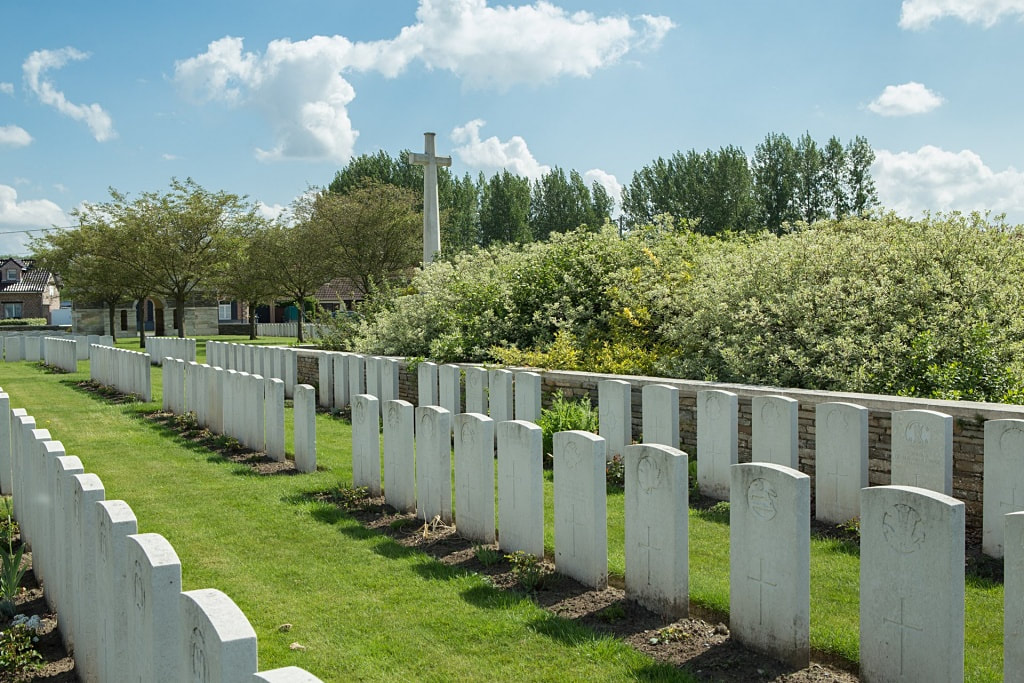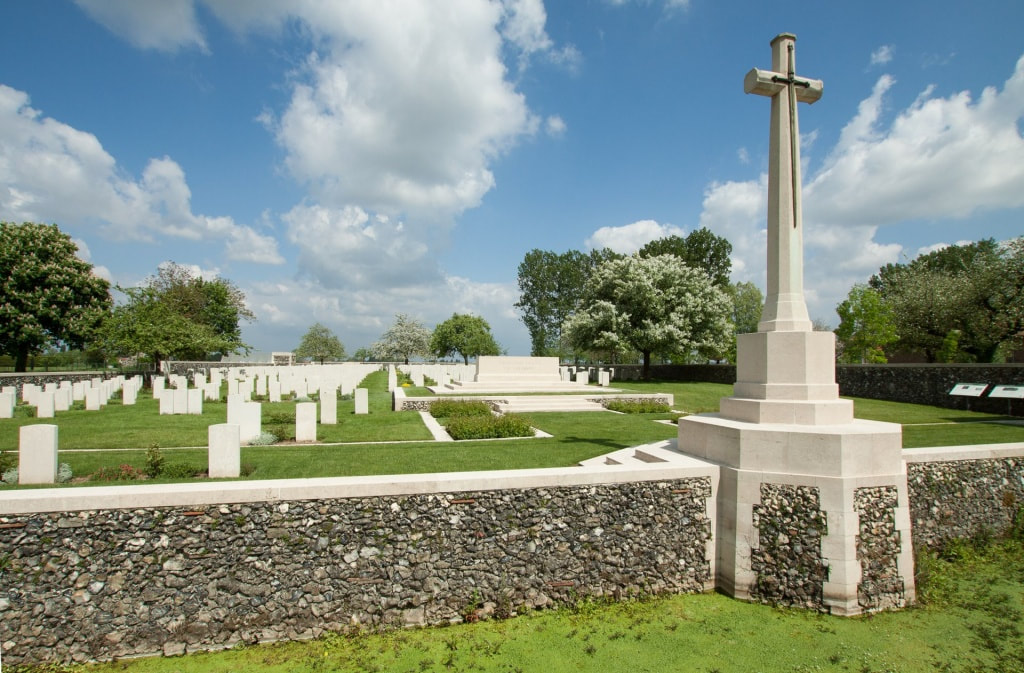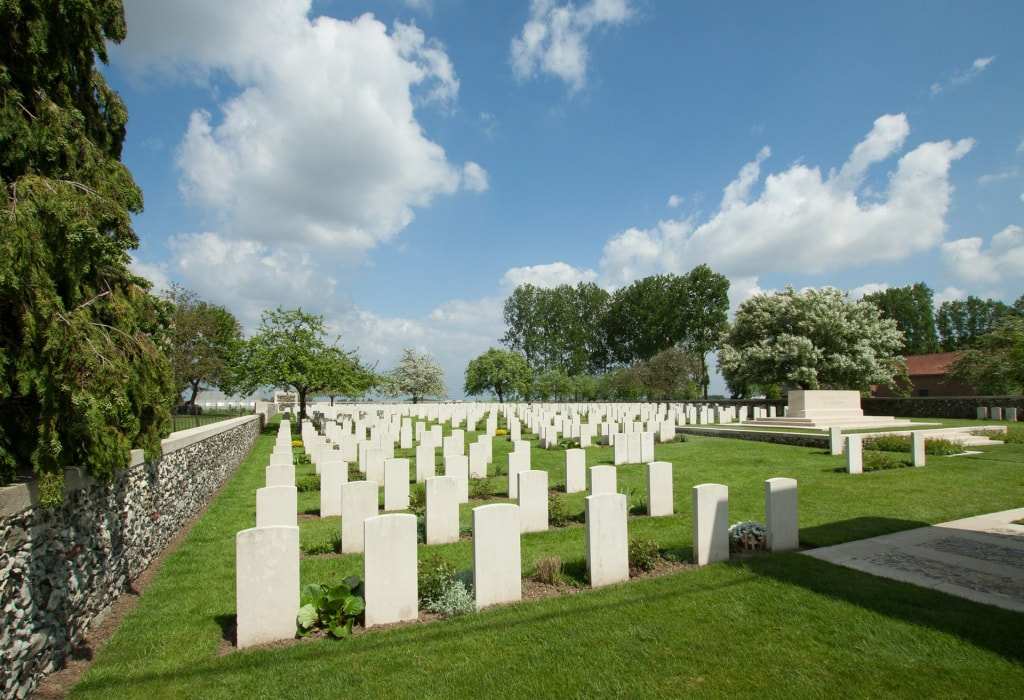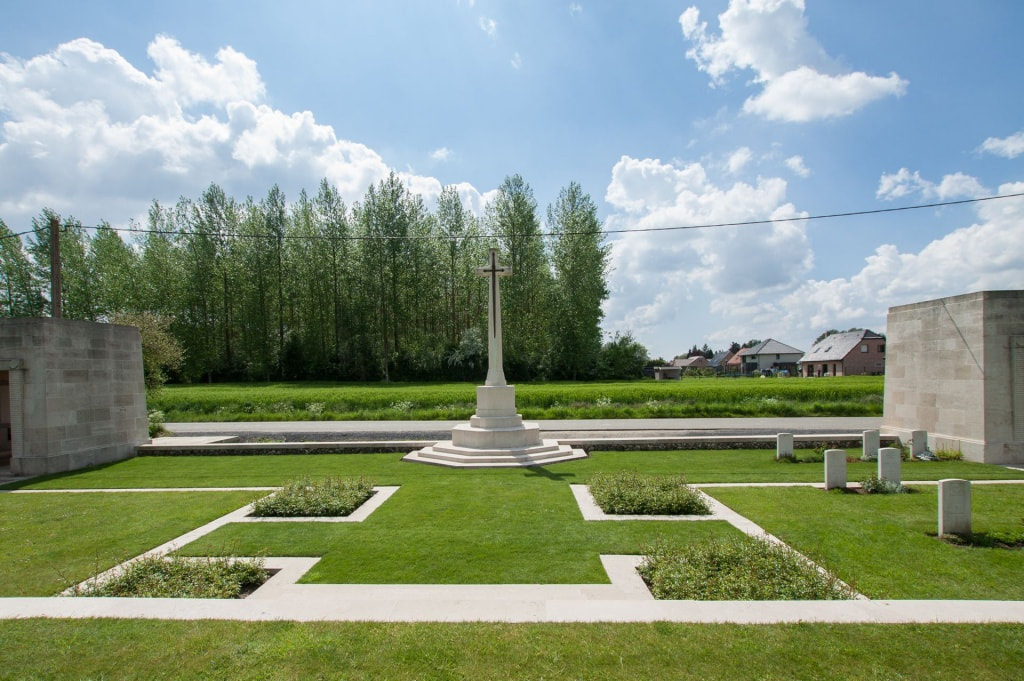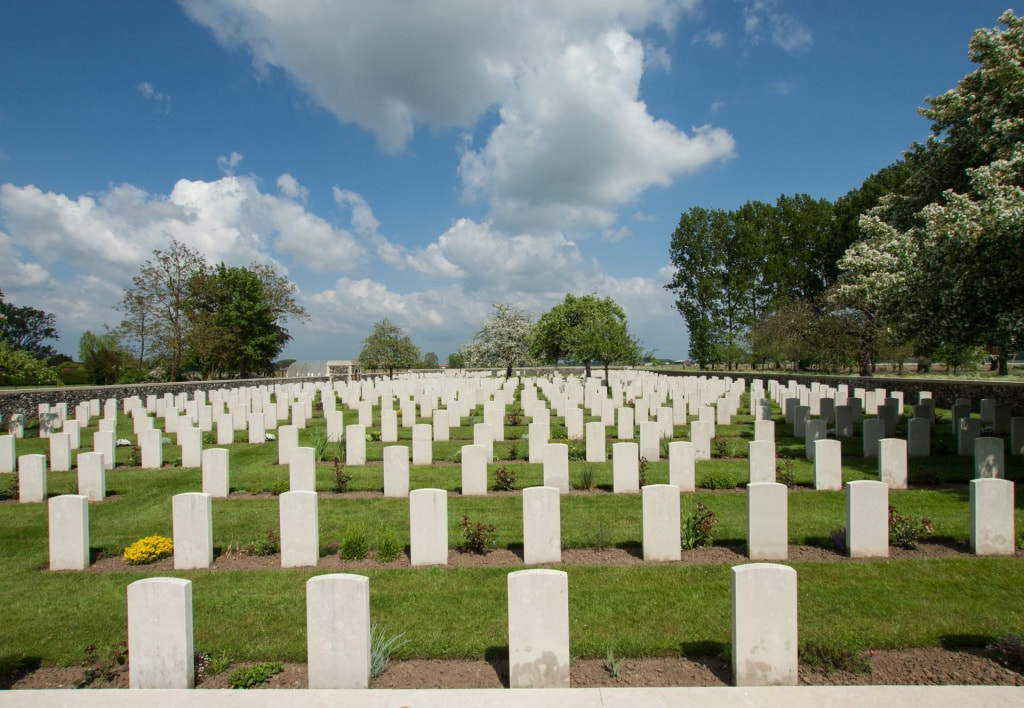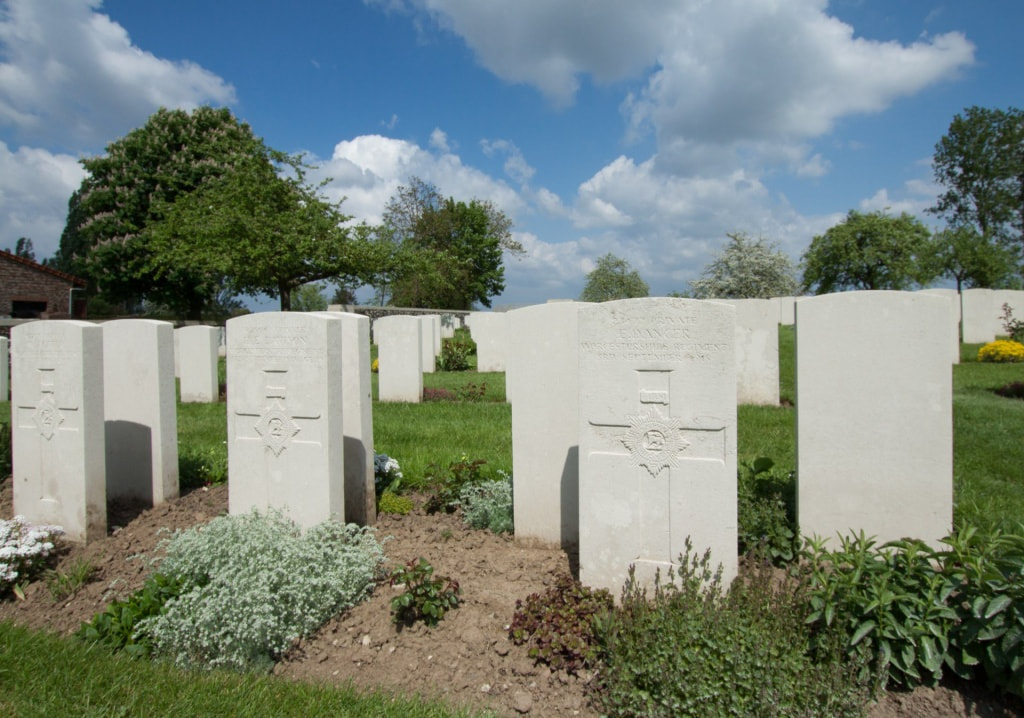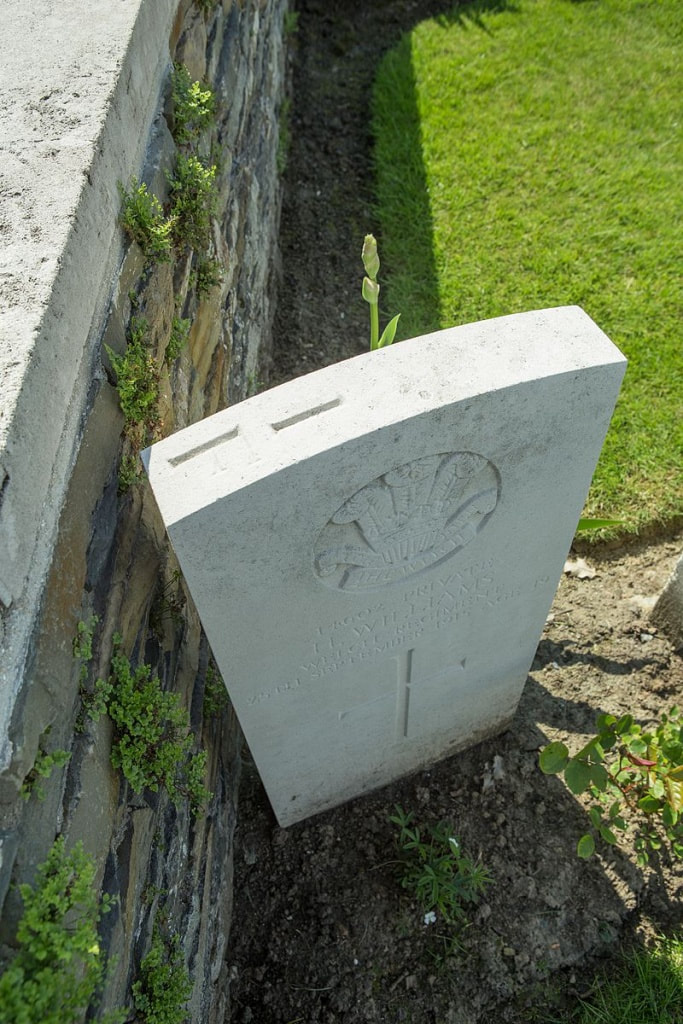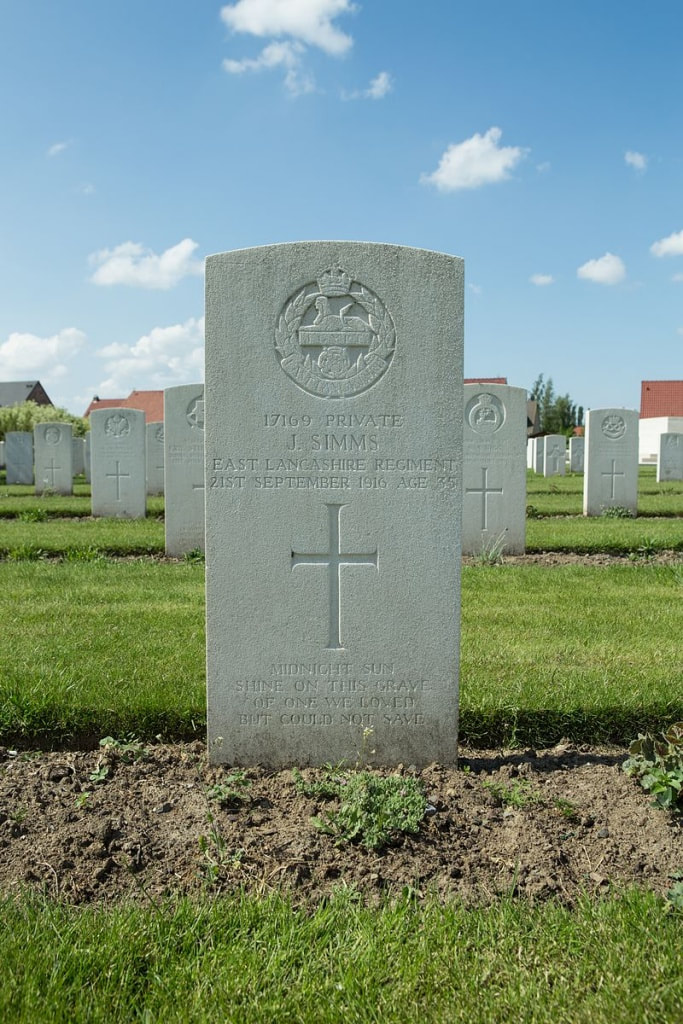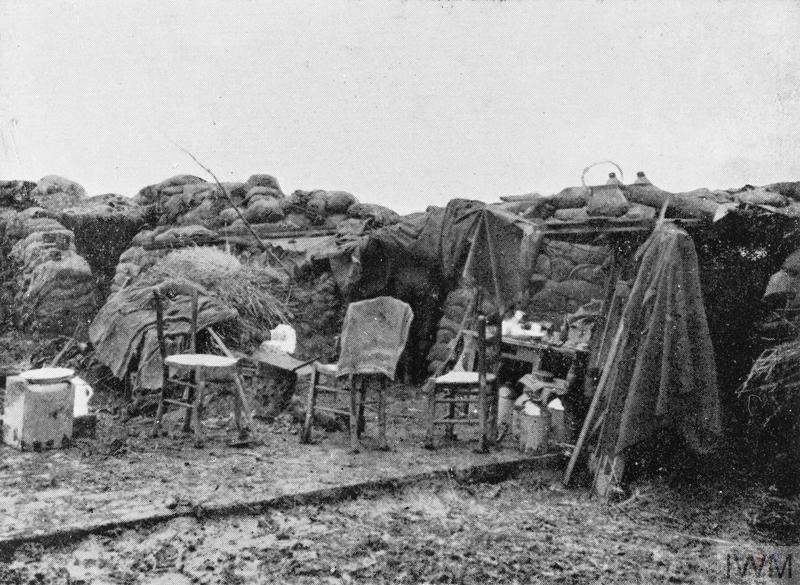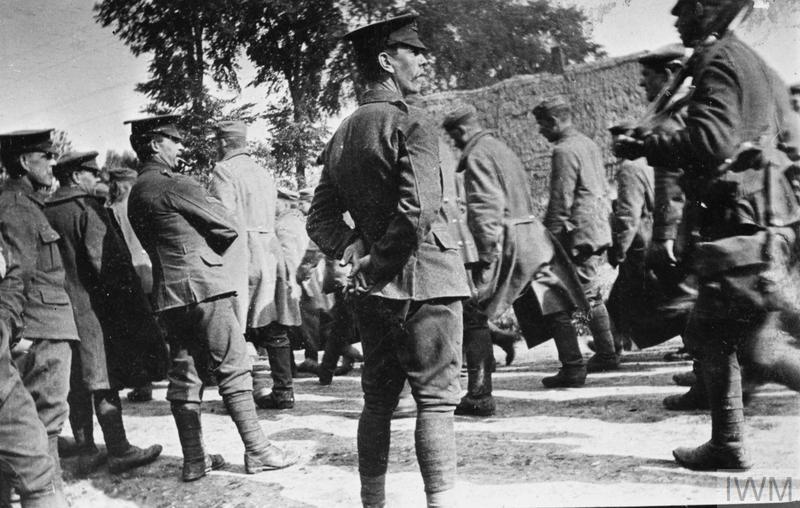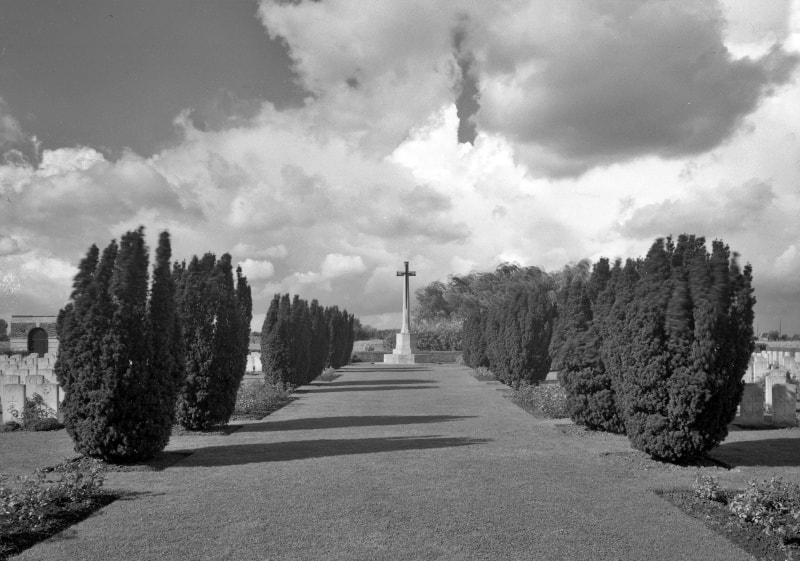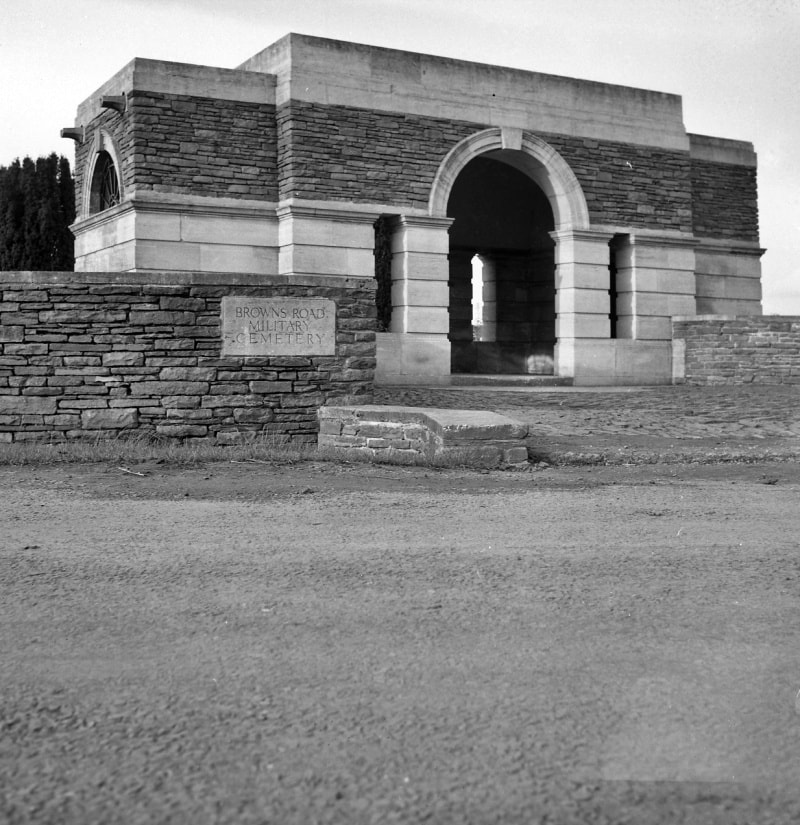BROWN'S ROAD MILITARY CEMETERY
Festubert
Pas De Calais
France
GPS Coordinates Latitude: 50.54045 Longitude: 2.73317
Location Information
Festubert is a village 8 kilometres east-north-east of Bethune.
From the church in Festubert, take the D166 signposted Cuinchy. After 300 metres turn right. Brown's Road Military Cemetery will be found a further 300 metres along this road on the right hand side.
Historical Information
Festubert was occupied by Commonwealth forces in October 1914 and on 23-24 November, the Indian Corps repulsed a German attack. The Battle of Festubert (15-25 May 1915) resulted in a short advance which left the village somewhat less exposed than it had been. Except for an advance which was attempted just to the south of Festubert (the Second Action of Givenchy, 15-16 June 1915), this sector remained quiet until 9 April 1918 and the beginning of the Battle of the Lys. Festubert was held by the 55th (West Lancashire) Division against the German assault, and successive attacks lasting through the month were repelled by the 1st and other Divisions. It remained an outpost for Commonwealth forces until the final advance began in September 1918.
The cemetery was begun in October 1914, and carried on by fighting units and field ambulances until November 1917, when it contained 299 graves. It was greatly enlarged after the Armistice when graves were brought in from small cemeteries and isolated sites on the surrounding battlefields.
The more sizeable of the graveyards concentrated here were:-
CHEYNE WALK CEMETERY, GIVENCHY, on the road from Givenchy to Cuinchy, named from a trench. It was part of a cafe and garden, and it contained the graves of 13 soldiers from the United Kingdom who fell in October and December, 1914.
LE PLANTIN SOUTH CEMETERY, GIVENCHY, on the road leading South from the hamlet of Le Plantin to Windy Corner. It contained the graves of 33 soldiers from the United Kingdom, and it was used from October, 1914 to December, 1916.
LE PLANTIN CEMETERY (WELSH CHAPEL), FESTUBERT, on the South-West side of the road at Le Plantin North. It contained the graves of 43 soldiers from the United Kingdom (largely O.B.L.I. and 2nd Black Watch) and four from Canada, and it was used from December, 1914 to December, 1915.
Brown's Road Cemetery now contains 1,071 burials and commemorations of the First World War. 404 of the burials are unidentified but special memorials commemorate three casualties believed to be buried among them.
Total Burials: 1071.
Identified Casualties: United Kingdom 643, Canada 18, South Africa 6. Total 667.
Unidentified Casualties: 404.
The cemetery was designed by Charles Holden and W. C. Von Berg
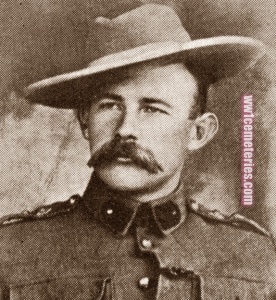
Major
William Lewis Campbell Allan
2nd Bn. King's Own Scottish Borderers
14th October 1914, aged 43.
Plot V. E. 1.
Son of Maj. Gen. William Allan and the late Mrs. Allan (nee Kinloch).
William Lewis Campbell Allan
2nd Bn. King's Own Scottish Borderers
14th October 1914, aged 43.
Plot V. E. 1.
Son of Maj. Gen. William Allan and the late Mrs. Allan (nee Kinloch).
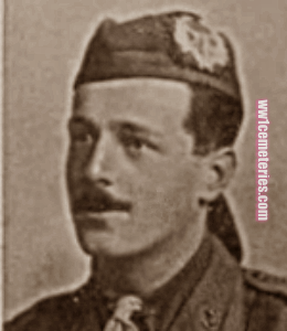
Lieutenant
John Douglas Alston
3rd Bn. attd. 2nd Bn. Cameronians (Scottish Rifles)
10th March 1915, aged 24.
Plot VIII. J. 1.
Son of Andrew T. and Georgina Cowie Alston, of Thornhill, Airdrie, Lanarkshire.
John Douglas Alston
3rd Bn. attd. 2nd Bn. Cameronians (Scottish Rifles)
10th March 1915, aged 24.
Plot VIII. J. 1.
Son of Andrew T. and Georgina Cowie Alston, of Thornhill, Airdrie, Lanarkshire.
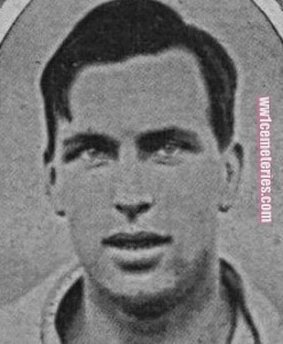
Captain
David McLaren Bain
3rd Bn. attd. 2nd Bn. Gordon Highlanders
3rd June 1915, aged 24.
Plot VIII. F. 14.
Son of William and Edith Bain, of 42, Moray Place, Edinburgh. Scottish Rugby International.
David McLaren Bain
3rd Bn. attd. 2nd Bn. Gordon Highlanders
3rd June 1915, aged 24.
Plot VIII. F. 14.
Son of William and Edith Bain, of 42, Moray Place, Edinburgh. Scottish Rugby International.
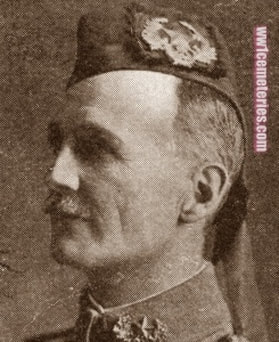
Lieutenant Colonel
Wilfrid Marryat Bliss
Commanding 2nd Bn. Cameronians (Scottish Rifles)
10th March 1915, aged 49.
Plot VIII. J. 10.
Brother of Miss Muriel E. Bliss, of 81, Philbeach Gardens, Earl's Court, London.
Wilfrid Marryat Bliss
Commanding 2nd Bn. Cameronians (Scottish Rifles)
10th March 1915, aged 49.
Plot VIII. J. 10.
Brother of Miss Muriel E. Bliss, of 81, Philbeach Gardens, Earl's Court, London.
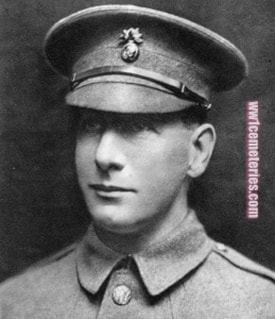
2749 Private
Geoffrey Horsman Coles
24th Bn. Royal Fusiliers
27th January 1916, aged 44.
Plot I. G. 17.
Son of Timothy Horsman Coles and Amelia Coles, of St. Helen's, Hastings, Sussex.
Geoffrey Horsman Coles
24th Bn. Royal Fusiliers
27th January 1916, aged 44.
Plot I. G. 17.
Son of Timothy Horsman Coles and Amelia Coles, of St. Helen's, Hastings, Sussex.
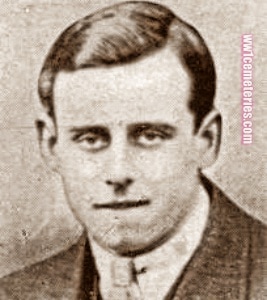
Lieutenant
Richard William Danckwerts
1st Bn. Gloucestershire Regiment
22nd December 1914, aged 21.
Plot VII. D. 9.
Son of the late W.O. Danckwerts, K.C. and Mrs. Danckwerts, of Orsett Terrace, Hyde Park, London.His brother Victor Hilary Dankwerts C M G fell in the 1939 – 1945 War.
Richard William Danckwerts
1st Bn. Gloucestershire Regiment
22nd December 1914, aged 21.
Plot VII. D. 9.
Son of the late W.O. Danckwerts, K.C. and Mrs. Danckwerts, of Orsett Terrace, Hyde Park, London.His brother Victor Hilary Dankwerts C M G fell in the 1939 – 1945 War.
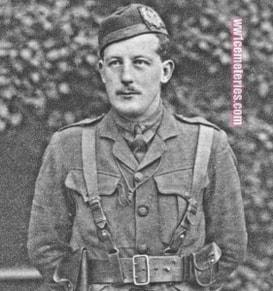
Lieutenant, The Honourable
John De Blaquiere
2nd Bn. Cameronians (Scottish Rifles)
10th March 1915, aged 25.
Plot VIII. J. 5.
Son of William, 6th Baron de Blaquiere, and Lucienne Baroness de Blaquiere, O.B.E., of 3, The Circus, Bath.
John De Blaquiere
2nd Bn. Cameronians (Scottish Rifles)
10th March 1915, aged 25.
Plot VIII. J. 5.
Son of William, 6th Baron de Blaquiere, and Lucienne Baroness de Blaquiere, O.B.E., of 3, The Circus, Bath.
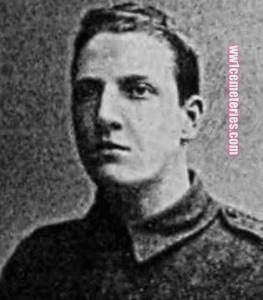
3119 Private
Thomas Edward Flook
"D" Coy. London Regiment (Prince of Wales' Own Civil Service Rifles)
24th May 1915, aged 21.
Plot I. A. 19.
Son of Joseph Thomas and Elizabeth Flook.
Thomas Edward Flook
"D" Coy. London Regiment (Prince of Wales' Own Civil Service Rifles)
24th May 1915, aged 21.
Plot I. A. 19.
Son of Joseph Thomas and Elizabeth Flook.
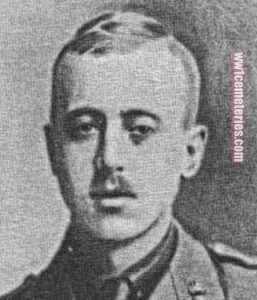
Lieutenant
Frederick Douglas Leach Green
6th Bty. 2nd Bde. Canadian Field Artillery
2nd June 1915, aged 25.
Plot IV. A. 7.
Son of F. W. and Annie L. Green, of Calle Napolet 63, Mexico City, Mexico. Born at Halifax, Nova Scotia.
Frederick Douglas Leach Green
6th Bty. 2nd Bde. Canadian Field Artillery
2nd June 1915, aged 25.
Plot IV. A. 7.
Son of F. W. and Annie L. Green, of Calle Napolet 63, Mexico City, Mexico. Born at Halifax, Nova Scotia.
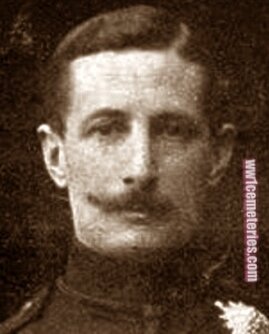
Major
Ernest De Lannoy Hayes
2nd Bn. Cameronians (Scottish Rifles)
10th March 1915, aged 45.
Plot VIII. J. 9.
Son of Julia McCoy (formerly Hayes) and the late Admiral Montagu Hayes; husband of Constance Frances Hayes, of 6, Wilbraham Mansions, Wilbraham Place, London S.W.
Ernest De Lannoy Hayes
2nd Bn. Cameronians (Scottish Rifles)
10th March 1915, aged 45.
Plot VIII. J. 9.
Son of Julia McCoy (formerly Hayes) and the late Admiral Montagu Hayes; husband of Constance Frances Hayes, of 6, Wilbraham Mansions, Wilbraham Place, London S.W.
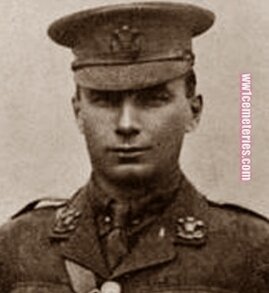
Captain
Horace Falkland Herd
3rd Bn. attd. 2nd Bn. Welsh Regiment
27th December 1914, aged 31.
Plot I. C. 1.
Son of Major W.G.R. Herd. served in the South African War.
Horace Falkland Herd
3rd Bn. attd. 2nd Bn. Welsh Regiment
27th December 1914, aged 31.
Plot I. C. 1.
Son of Major W.G.R. Herd. served in the South African War.
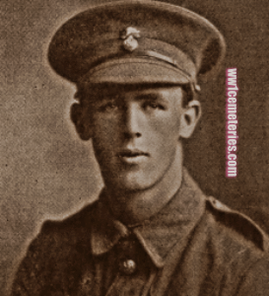
2860 Private
Siegfried Wedgwood Herford
24th Bn. Royal Fusiliers
28th January 1916, aged 24.
Plot I. G. 20.
Son of Charles and Marie Herford, of 5, Parkfield Rd., Didsbury, Manchester.
Siegfried Wedgwood Herford
24th Bn. Royal Fusiliers
28th January 1916, aged 24.
Plot I. G. 20.
Son of Charles and Marie Herford, of 5, Parkfield Rd., Didsbury, Manchester.
Shot at Dawn
5/3119 Rifleman W. Bellamy, 1st Bn. King's Royal Rifle Corps, executed for cowardice 16th July 1915, aged 34. Plot 4. D. 19.
He was a reservist who had joined the army in 1898. On 24 June 1915, in an area near Cambrin where the British & German trenches ran close together, 2 mines were exploded, Bellamy’s company was ordered to stand to. Bellamy refused to obey his platoon sergeant’s order, twice repeated, to leave his dugout & open fire after the first mine had exploded, telling a corporal, whose order he also defied: ‘I can’t get up. I am too shaky’.
At trial, Bellamy made a statement saying that he had suffered from nervous disability in the past & that the least shock upset his nerves. He added that he had been examined twice by doctors in 1913; & that after the explosion of the first mine, his nerves were so shaky that he did not know what he was doing.
After conviction, the Brigade commander suggested a retrial because of a technical irregularity & since Bellamy’s medical defence had not been addressed. No retrial was in fact considered necessary, a medical board of 3 doctors being convened — which found no mental disability or nervous debility.
The CO gave Bellamy a bad character, both in general & as a fighting man. The Brigade commander, seemingly influenced in the end by information that Bellamy had on a previous occasion left his post without permission — an offence not known to the convicting court, where his conduct sheet had not been produced —recommended execution, the Corps commander likewise, so long as the evidence was considered legally sufficient on the charge of cowardice. (Corns, pp. 183-185, 211)
15251 Private George Henry Lowton, 17th Bn. Sherwood Foresters (Notts & Derby Regiment), executed for cowardice 30th July 1916, aged 36. Plot 5. G. 13. Son of William and Margaret Lowton, of Nottingham.
He enlisted in Sept 1914, arriving in France in Dec 1915. On the night of 3 July 1916, at Richebourg l’Avoué, his battalion had taken part in a successful trench raid, but had left behind some trench ladders, only 75 yards from the German line.
The following night, Lawton & others were ordered to retrieve them from No-man’s-land, but Lawton repeatedly refused, saying that he had a wife & children, & suggesting that it would be sudden death to go out. He was arrested, & when given another chance, still would not join the party when it went out.
At trial, his defence was brief. He told the court that in Feb 1916 he had been buried by a shell explosion, suffering injuries to his leg & back, & spending a month in hospital at Etaples. ‘Until this happened to me, I feared nothing, but this accident has fairly upset me….On the night of 4 July I was still suffering from the effects of the February affair’. Despite awarding a death sentence, the court strongly recommended mercy on account of Lawton’s previous good character & his being buried by the shell explosion; &, further, recommended examination by a medical board — which however on 22 July found Lawton to be ‘in good health in every way’.
The Brigade & Divisional commanders were for commutation, but the Army Commander could see ‘no extenuating circumstances of any significance’, & the C-in-C confirmed the sentence.(Corns, pp 189-191, 2120) Lawton was executed & buried along with McCubbin, below
31821 Private Bertie McCubbin, 17th Bn. Sherwood Foresters (Notts & Derby Regiment) executed for cowardice 30th July 1916. Plot 5. B. 16.
On 7 July, 3 days after the cowardice shown by Lawton (above), McCubbin was told by a sergeant that it was his turn to go out on listening patrol in front of the trenches at Festubert — to remain for an hour 40 yards beyond the parapet, the enemy trenches being 200-300 yards away. He demurred, saying: ‘I can’t go over, I’ve got very bad pains in my insides’. Report was made to the officer in charge, who made clear — in vain — the serious consequences of disobedience, McCubbin saying that he could not go over, for his nerves would not let him. ‘If I go over, I shall be a danger to the other man who is out there as well as to myself’. Upon his arrest, he added that the pains in his insides had started that evening.
McCubbin handed in a written statement in his defence, stating inter alia that his nerves had been ruined following a very close shell-burst & that his case was not one of blank refusal, but of nervousness worsened by the recent incessant bombardment; pleading his good conduct; & referring to his fear of what would happen to his mother & his 6 siblings if something happened to him & his father (who was also serving somewhere in France).
At the trial itself, he made no real defence, except to say that he had pains in his insides on the night in question.
Evidence was given by the Adjutant that McCubbin had always done his duty quite well, but that in the last 6 months ‘he has become unsteady generally, & also unstrung’. It further emerged that McCubbin had been on duty in the trenches for 26 days before 7 July.
The court’s strong recommendation to mercy was supported at the next 3 levels of review, but the Army commander disagreed, leading to confirmation by the C-in-C. (Corns, pp191-194, 212)
McCubbin was executed & buried alongside Lawton (above).
5/3119 Rifleman W. Bellamy, 1st Bn. King's Royal Rifle Corps, executed for cowardice 16th July 1915, aged 34. Plot 4. D. 19.
He was a reservist who had joined the army in 1898. On 24 June 1915, in an area near Cambrin where the British & German trenches ran close together, 2 mines were exploded, Bellamy’s company was ordered to stand to. Bellamy refused to obey his platoon sergeant’s order, twice repeated, to leave his dugout & open fire after the first mine had exploded, telling a corporal, whose order he also defied: ‘I can’t get up. I am too shaky’.
At trial, Bellamy made a statement saying that he had suffered from nervous disability in the past & that the least shock upset his nerves. He added that he had been examined twice by doctors in 1913; & that after the explosion of the first mine, his nerves were so shaky that he did not know what he was doing.
After conviction, the Brigade commander suggested a retrial because of a technical irregularity & since Bellamy’s medical defence had not been addressed. No retrial was in fact considered necessary, a medical board of 3 doctors being convened — which found no mental disability or nervous debility.
The CO gave Bellamy a bad character, both in general & as a fighting man. The Brigade commander, seemingly influenced in the end by information that Bellamy had on a previous occasion left his post without permission — an offence not known to the convicting court, where his conduct sheet had not been produced —recommended execution, the Corps commander likewise, so long as the evidence was considered legally sufficient on the charge of cowardice. (Corns, pp. 183-185, 211)
15251 Private George Henry Lowton, 17th Bn. Sherwood Foresters (Notts & Derby Regiment), executed for cowardice 30th July 1916, aged 36. Plot 5. G. 13. Son of William and Margaret Lowton, of Nottingham.
He enlisted in Sept 1914, arriving in France in Dec 1915. On the night of 3 July 1916, at Richebourg l’Avoué, his battalion had taken part in a successful trench raid, but had left behind some trench ladders, only 75 yards from the German line.
The following night, Lawton & others were ordered to retrieve them from No-man’s-land, but Lawton repeatedly refused, saying that he had a wife & children, & suggesting that it would be sudden death to go out. He was arrested, & when given another chance, still would not join the party when it went out.
At trial, his defence was brief. He told the court that in Feb 1916 he had been buried by a shell explosion, suffering injuries to his leg & back, & spending a month in hospital at Etaples. ‘Until this happened to me, I feared nothing, but this accident has fairly upset me….On the night of 4 July I was still suffering from the effects of the February affair’. Despite awarding a death sentence, the court strongly recommended mercy on account of Lawton’s previous good character & his being buried by the shell explosion; &, further, recommended examination by a medical board — which however on 22 July found Lawton to be ‘in good health in every way’.
The Brigade & Divisional commanders were for commutation, but the Army Commander could see ‘no extenuating circumstances of any significance’, & the C-in-C confirmed the sentence.(Corns, pp 189-191, 2120) Lawton was executed & buried along with McCubbin, below
31821 Private Bertie McCubbin, 17th Bn. Sherwood Foresters (Notts & Derby Regiment) executed for cowardice 30th July 1916. Plot 5. B. 16.
On 7 July, 3 days after the cowardice shown by Lawton (above), McCubbin was told by a sergeant that it was his turn to go out on listening patrol in front of the trenches at Festubert — to remain for an hour 40 yards beyond the parapet, the enemy trenches being 200-300 yards away. He demurred, saying: ‘I can’t go over, I’ve got very bad pains in my insides’. Report was made to the officer in charge, who made clear — in vain — the serious consequences of disobedience, McCubbin saying that he could not go over, for his nerves would not let him. ‘If I go over, I shall be a danger to the other man who is out there as well as to myself’. Upon his arrest, he added that the pains in his insides had started that evening.
McCubbin handed in a written statement in his defence, stating inter alia that his nerves had been ruined following a very close shell-burst & that his case was not one of blank refusal, but of nervousness worsened by the recent incessant bombardment; pleading his good conduct; & referring to his fear of what would happen to his mother & his 6 siblings if something happened to him & his father (who was also serving somewhere in France).
At the trial itself, he made no real defence, except to say that he had pains in his insides on the night in question.
Evidence was given by the Adjutant that McCubbin had always done his duty quite well, but that in the last 6 months ‘he has become unsteady generally, & also unstrung’. It further emerged that McCubbin had been on duty in the trenches for 26 days before 7 July.
The court’s strong recommendation to mercy was supported at the next 3 levels of review, but the Army commander disagreed, leading to confirmation by the C-in-C. (Corns, pp191-194, 212)
McCubbin was executed & buried alongside Lawton (above).

